Spotting an acrobatic flash of yellow flitting around the garden, feeding on flowering seed heads or foraging at bird feeders is a common occurrence in many yards throughout the United States in summer. Very likely you’ve seen a male American goldfinch, with a distinctive black cap to accompany his sweet-corn-yellow summer plumage. The American goldfinch is the state bird of New Jersey, Iowa and Washington, likely because it can be seen year-round in these states, and many others.
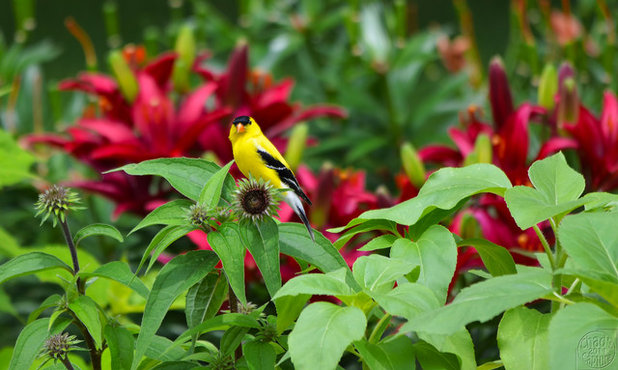
Chad Horwedel
Shown: A male American goldfinch with summer breeding plumage on an immature echinacea and sunflower.
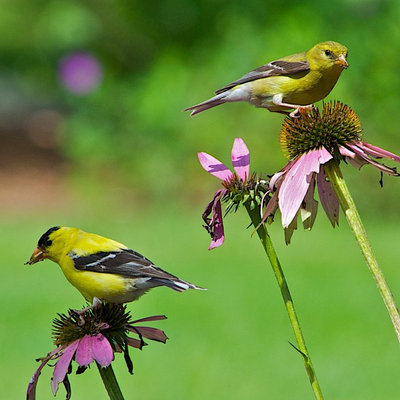
Distant Hill Gardens
Latin name: Spinus tristis Common name: American goldfinch
Distribution: The range of the American goldfinch in the United States is vast; these birds are seen in more than 30 states east to west; some spend summers as far north as southern Canada, and some overwinter in the southeastern or southwestern U.S.
Habitat: Forest edges, gardens and shrubby fields
When to look for them. Goldfinches can be found in many North American yards year-round. You might not notice them in the winter, though, when they are missing their bright yellow summer plumage.
How to spot American goldfinches. Unlike the brilliant summer yellow of the male, females have dull yellow body feathers intermingled with olive coloration on the head, back, stomach and chest year-round. See if you can tell which is the male and which is the female in this image.
In the winter, females and males look very similar. Both males and females have creamy pinkish bills specialized to feed on the small seeds of flowering plants, like the purple coneflower (
Echinacea purpurea) pictured here. Beaks of this shape are one of the critical body elements used to identify birds in the finch family.
These birds are on the small side, and both sexes have distinctive black and white wing markings that help differentiate them from other finch species. They can often be found in small flocks moving among the vegetation in open areas.
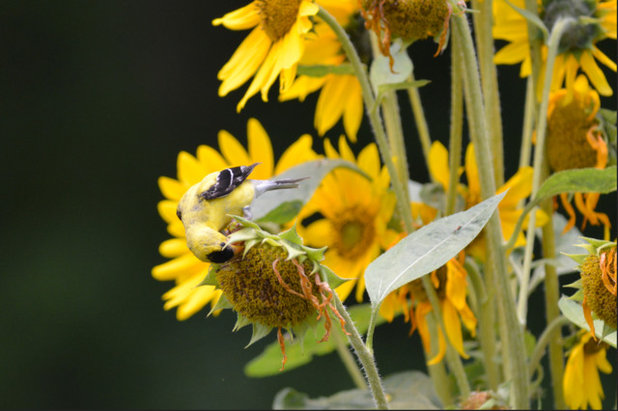
Deborah Bifulco
How to Attract American GoldfinchesUnique among songbirds, goldfinches are vegetarian, and more specifically, granivores (seed eaters). Most North American songbirds will feed their offspring insects during nesting season, but not American goldfinches. Due to their unique adaptation, they establish nests later in the nesting season, usually in late June or early July in the East, when seed heads are abundant enough to support their nestlings.
Finches often forage on grass seed heads or in trees such as alder, birch and western redcedar.
Provide plants they love. Goldfinches love plants like thistle (
Cynareae spp.) and others in the Asteraceae family, including sunflowers and asters, and common milkweed (
Asclepias syriaca).
See how to grow more milkweed species
When planting thistle, make sure to choose native, noninvasive species, like field thistle (
Cirsium discolor), Flodman’s thistle (
C. flodmanii), wavyleaf thistle (
C. undulatum) or cobweb thistle (
C. occidentale).
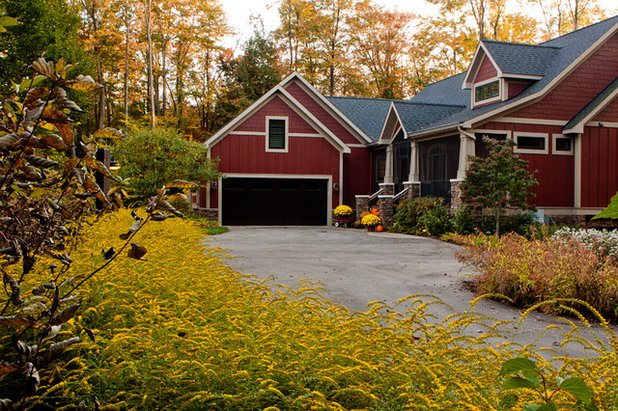
Blue Ridge Landscaping
Offer the ideal habitat. These birds nest in an ideal seed-hunting habitat, such as shrubby fields, open flood plains and forest edges. In urban areas they frequent city parks and backyards that provide an ideal habitat. Luxurious plantings of goldenrod (
Solidago spp.), like that pictured here, are seductive spaces for entire flocks of American goldfinches.
Goldfinches build their nests in shrubs or saplings. They tend to build them several feet off the ground, though, so choose larger shrub species native to your area to maximize your chance of hosting a breeding pair.
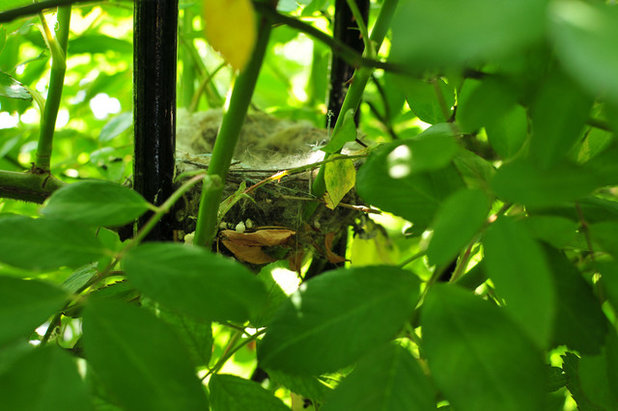
See if you can spot their open-cup nests, which are about 3 inches across and 3 to 4 inches tall. The dense summer foliage can make them tricky to find. The nest is tightly woven, sometimes sturdy enough to hold water, with the fibers of the birds’ favorite seed-producing plants used in the weaving pattern or as a soft lining. Thistles and milkweeds, with their abundant seeds and fluffy down, are both a food source and a nesting material for these late-season breeders.
Photo by Ed Ralph
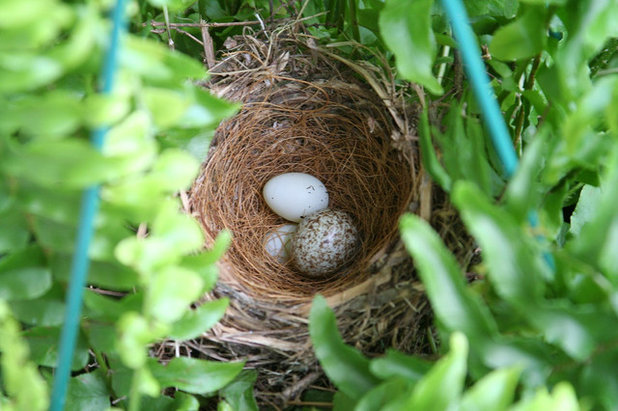
Habitat Network: The Cornell Lab of Ornithology
American goldfinches’ late nesting season and exclusive seed diet may help protect their young from brood parasites like the brown-headed cowbird (
Molothrus ater), which lays its eggs in the nests of other birds (see if you can spot the cowbird egg here). The vegetarian diet is insufficient to properly satiate the voracious appetite of these brood parasites, and they quickly perish, leaving the nest to the original inhabitants.
If the timing is right and food sources are abundant, females will often leave the first nest to find another mate and lay a second set of eggs. If this venture is successful, the result is a second-clutch fledgling as late as September in some places.
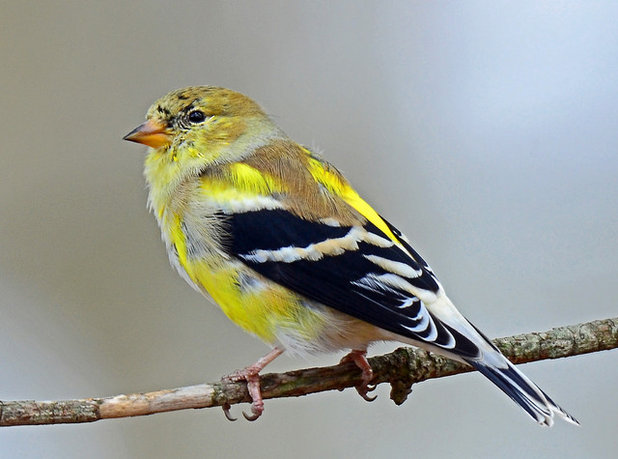
Timing is critical, as the birds molt a second time after rearing their young. American goldfinches are the only finches that molt two times a year, once in late winter and once again after their last clutch. This image shows a male midmolt. Some of these now-dulled yellow finches fly farther south for the winter, but many overwinter in their summer range. Due to their drastic coloration change, it is easy to overlook them at your feeders in the winter.
Photo by Rodney Campbell
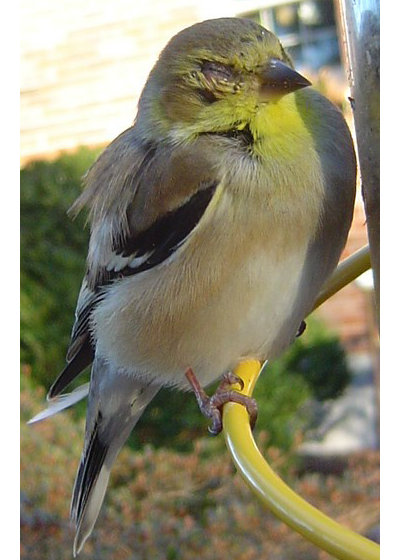
Teresa Wiley
Keep feeders full and clean. If you enjoy feeding birds, consider having a consistent supply of sunflower and Nyjer seeds available in the winter. Like other species of finches, American goldfinches are susceptible to contracting mycoplasmal conjunctivitis, commonly called house finch eye disease, at bird feeders. To reduce this risk, clean your feeders with soap and water once or twice a month. If you spot birds with crusted-over or abscessed eyes, immediately take down your feeders and clean them with a 10 percent bleach solution (1 part bleach and 9 parts water). Leaving the feeders down for a week or so will also help disperse the birds and keep the disease from spreading.
One way to monitor birds at your feeders is to participate in the Cornell Lab of Ornithology program, Project Feeder Watch, documenting birds that visit your feeders in November to April.
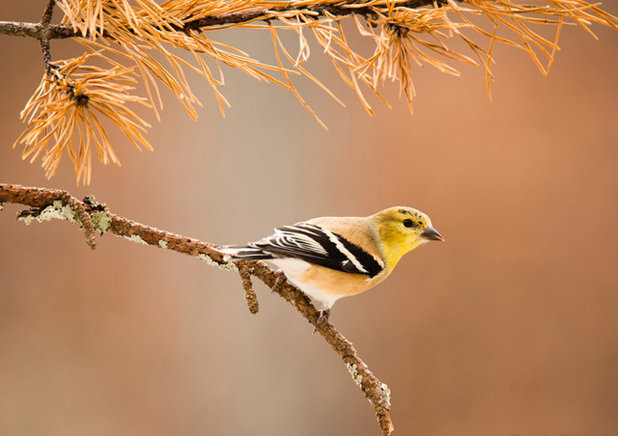
Christy Cox Photography
American goldfinches are a true national treasure. Their unique adaptations make them an object of fascination and admiration for backyard gardeners and ornithologists alike. Their vegetarian diets are another reminder of the importance of planting and maintaining native species of flowering plants so we can continue to provide an ideal habitat for these late-season nesters. This late summer and fall, collect those thistle, sunflower, goldenrod and milkweed seeds, and establish a healthy patch in your backyard to support next year’s yellow wonders.
Shown: A male goldfinch with winter plumage
YardMap is a citizen science project developed by the Cornell Lab of Ornithology, designed to cultivate a richer understanding of bird habitat, for both professional scientists and people concerned with their local environment. Thousands of people are documenting their conservation efforts at home to support birds and other wildlife in their yards.





